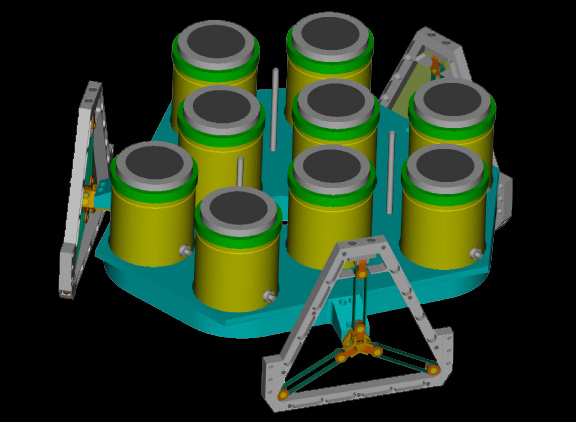|
|

|
|
|
|
Germanium Detectors
|
|
|
|

|
| |
Germanium detectors cover the entire hard X-ray to gamma-ray line energy range (up
to ~20 MeV) with the highest spectral resolution of any detectors. They have been flown on the HEAO-3, Mars Observer,
and, most recently, Wind spacecraft (UCB designed/fabricated GeD). Internally segmented GeDs appropriate for HESSI
were developed by UCB (Luke 1984), and since 1988 over twenty have been successfully flown on
HEXAGONE, HIREGS,
and other balloon payloads (Smith et al. 1993, 1995; Pelling et al. 1992, Feffer et al. 1993). These have proven
to be very robust; the first ones fabricated and flown are still operating.
The HESSI GeD design provides wide energy coverage, from ~3 keV soft X-rays to ~20 MeV gamma-rays with a single
mechanically robust detector. The largest, readily available, hyperpure (n-type) coaxial Ge material (~7.1-cm diam
x 8.5-cm long) will be used. The inner electrode is segmented into three contacts that collect charge from three
electrically independent detector segments, defined by the electric field pattern. This provides the equivalent
of a ~1-cm thick planar GeD in front of a thick ~7-cm coaxial GeD, plus a bottom <~0.5-cm "guard-ring".
The top and curved outer surfaces are implanted with a thin (~0.3-µm) boron layer to provide a surface transparent
down to ~3 keV X-rays. The front segment's closed-end "pancake" configuration is electrically identical
(with the same low capacitance) to a commercial ORTEC "LO-AX"
GeD. Together with an advanced FET and
state-of-the-art electronics, this front segment will easily achieve the 3 keV energy threshold of a LO-AX
GeD.
Thus, a separate detector (and its electronics, etc.) is not required for 3-20 keV measurements.
A window of 20 mils rolled foil beryllium in the cryostat (similar to HEXAGONE) covers the central ~0.2-cm2 of
each GeD with the rest covered by 30 mils aluminum, so that low energy photons are absorbed in the high electric
field region over the center contact for optimal charge collection. This window allows for observations of the
iron line complex and thermal continuum down to 3 keV with ~0.5 keV FWHM resolution.
The front segment thickness is chosen to stop photons up to ~150 keV, where photoelectric absorption dominates,
while minimizing the active volume for background. Front-incident photons that Compton-scatter, and background
photons or particles entering from the rear, are rejected by anticoincidence with the rear segment; a passive,
graded-Z (Pb, Cu, Sn) ring around the front segment absorbs hard X-rays incident from the side, to provide the
unusually low background of a phoswich-type scintillation detector.
Photons with energies from ~150 keV to ~20 MeV, including all nuclear gamma-ray lines, stop primarily in the thick
rear segment alone, with smaller fractions stopping in the front segment, depositing energy in both the front and
rear segments, or in two or more GeDs. All these modes contribute to the total photopeak efficiency.
The intense 3-150 keV X-ray fluxes that usually accompany large gamma-ray line flares are absorbed by the front
segment, so the rear segment will always count at moderate rates. This is essential for gamma-ray line measurements
with optimal spectral resolution and high throughput.
Photons >~20 keV from non-solar sources can penetrate the thin aluminum cryostat wall from the side and be detected
by the GeD rear segments.
Contamination of the intrinsic (flat rear) surface, leading to increased surface leakage current and noise, is
the most common failure mode for GeDs. For planar GeDs and silicon detectors, guard rings have long been used to
isolate and drain off the leakage current of the intrinsic surfaces. Two years ago, we
(UCB) developed the first
guard-ring coaxial GeDs, using our segmentation technique to divide the internal electrode <~0.5 cm above the
intrinsic (flat) rear surface. Tests with a prototype coaxial guard ring GeD showed no degradation for surface
leakage currents of one nanoamp (~ten times higher than usable for non-guard-ring
GeDs), and only a few hundred eV broadening in resolution for currents of 10
nanoamps. This increased resistance
to contamination, by a factor of ~102, allows the use of a single vacuum enclosure for all 9 GeDs instead of the
more complex and expensive
hermetic encapsulation of individual detectors. |
|